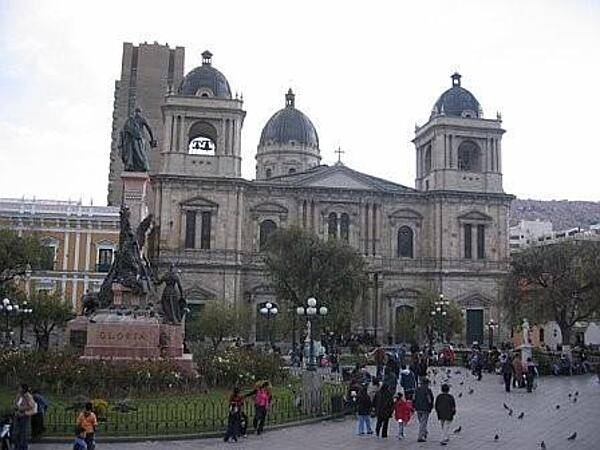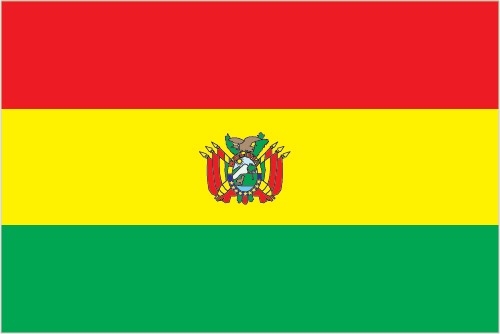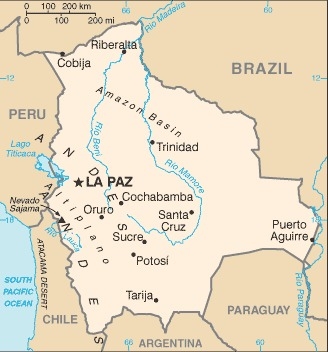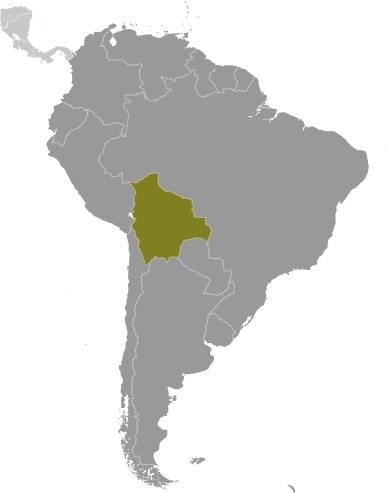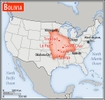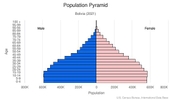Introduction
Background
Bolivia, named after independence fighter Simon BOLIVAR, broke away from Spanish rule in 1825; much of its subsequent history has consisted of a series of coups and countercoups, with the last coup occurring in 1978. Democratic civilian rule was established in 1982, but leaders have faced difficult problems of deep-seated poverty, social unrest, and illegal drug production.
In December 2005, Bolivians elected Movement Toward Socialism leader Evo MORALES president - by the widest margin of any leader since the restoration of civilian rule in 1982 - after he ran on a promise to change the country's traditional political class and empower the nation's poor, indigenous majority. In December 2009 and October 2014, President MORALES easily won reelection. His party maintained control of the legislative branch of the government, which has allowed him to continue his process of change. In February 2016, MORALES narrowly lost a referendum to approve a constitutional amendment that would have allowed him to compete in the 2019 presidential election. However, a 2017 Supreme Court ruling stating that term limits violate human rights provided the justification for MORALES to be chosen by his party to run again in 2019. MORALES attempted to claim victory in the 20 October 2019 election, but widespread allegations of electoral fraud, rising violence, and pressure from the military ultimately forced him to flee the country. An interim government, led by President Jeanine ANEZ Chavez, prepared new elections that took place on 18 October 2020.
Visit the Definitions and Notes page to view a description of each topic.
Geography
Location
Central South America, southwest of Brazil
Geographic coordinates
17 00 S, 65 00 W
Map references
South America
Area
total: 1,098,581 sq km
land: 1,083,301 sq km
water: 15,280 sq km
Land boundaries
total: 7,252 km
border countries (5): Argentina 942 km, Brazil 3403 km, Chile 942 km, Paraguay 753 km, Peru 1212 km
Coastline
0 km (landlocked)
Maritime claims
none (landlocked)
Climate
varies with altitude; humid and tropical to cold and semiarid
Terrain
rugged Andes Mountains with a highland plateau (Altiplano), hills, lowland plains of the Amazon Basin
Elevation
highest point: Nevado Sajama 6,542 m
lowest point: Rio Paraguay 90 m
mean elevation: 1,192 m
Natural resources
tin, natural gas, petroleum, zinc, tungsten, antimony, silver, iron, lead, gold, timber, hydropower
Land use
agricultural land: 34.3% (2018 est.)
arable land: 3.6% (2018 est.)
permanent crops: 0.2% (2018 est.)
permanent pasture: 30.5% (2018 est.)
forest: 52.5% (2018 est.)
other: 13.2% (2018 est.)
Irrigated land
3,000 sq km (2012)
Major watersheds (area sq km)
Atlantic Ocean drainage: Amazon (6,145,186 sq km), Paraná (2,582,704 sq km)
Major aquifers
Amazon Basin
Major lakes (area sq km)
Fresh water lake(s): Lago Titicaca (shared with Peru) - 8,030 sq km
Salt water lake(s): Lago Poopo - 1,340 sq km
Major rivers (by length in km)
Rio de la Plata/Parana (shared with Brazil [s], Argentina, Paraguay, and Uruguay [m]) - 4,880 km
note – [s] after country name indicates river source; [m] after country name indicates river mouth
Population distribution
a high altitude plain in the west between two cordillera of the Andes, known as the Altiplano, is the focal area for most of the population; a dense settlement pattern is also found in and around the city of Santa Cruz, located on the eastern side of the Andes
Natural hazards
flooding in the northeast (March to April)
volcanism: volcanic activity in Andes Mountains on the border with Chile; historically active volcanoes in this region are Irruputuncu (5,163 m), which last erupted in 1995, and the Olca-Paruma volcanic complex (5,762 m to 5,167 m)
Geography - note
note 1: landlocked; shares control of Lago Titicaca, world's highest navigable lake (elevation 3,805 m), with Peru
note 2: the southern regions of Peru and the extreme northwestern part of Bolivia are considered to be the place of origin for the common potato, while southeast Bolivia and northwest Argentina seem to be the original development site for peanuts
People and Society
Nationality
noun: Bolivian(s)
adjective: Bolivian
Ethnic groups
Mestizo (mixed White and Amerindian ancestry) 68%, Indigenous 20%, White 5%, Cholo/Chola 2%, African descent 1%, other 1%, unspecified 3%; 44% of respondents indicated feeling part of some indigenous group, predominantly Quechua or Aymara (2009 est.)
note: results among surveys vary based on the wording of the ethnicity question and the available response choices; the 2001 national census did not provide "Mestizo" as a response choice, resulting in a much higher proportion of respondents identifying themselves as belonging to one of the available indigenous ethnicity choices; the use of "Mestizo" and "Cholo" varies among response choices in surveys, with surveys using the terms interchangeably, providing one or the other as a response choice, or providing the two as separate response choices
Languages
Spanish (official) 60.7%, Quechua (official) 21.2%, Aymara (official) 14.6%, Guarani (official) 0.6%, other native languages 0.4%, foreign languages 2.4%, none 0.1%; note - Bolivia's 2009 constitution designates Spanish and all indigenous languages as official; 36 indigenous languages are specified, including a few that are extinct (2001 est.)
major-language sample(s):
La Libreta Informativa del Mundo, la fuente indispensable de información básica. (Spanish)
The World Factbook, the indispensable source for basic information.
Religions
Roman Catholic 70%, Evangelical 14.5%, Adventist 2.5%, Church of Jesus Christ 1.2%, agnostic 0.3%, atheist 0.8%, other 3.5%, none 6.6%, unspecified 0.6% (2018 est.)
Demographic profile
Bolivia ranks at or near the bottom among Latin American countries in several areas of health and development, including poverty, education, fertility, malnutrition, mortality, and life expectancy. On the positive side, more children are being vaccinated and more pregnant women are getting prenatal care and having skilled health practitioners attend their births.
Bolivia’s income inequality is the highest in Latin America and one of the highest in the world. Public education is of poor quality, and educational opportunities are among the most unevenly distributed in Latin America, with girls and indigenous and rural children less likely to be literate or to complete primary school. The lack of access to education and family planning services helps to sustain Bolivia’s high fertility rate—approximately three children per woman. Bolivia’s lack of clean water and basic sanitation, especially in rural areas, contributes to health problems.
Between 7% and 16% of Bolivia’s population lives abroad (estimates vary in part because of illegal migration). Emigrants primarily seek jobs and better wages in Argentina (the principal destination), the US, and Spain. In recent years, more restrictive immigration policies in Europe and the US have increased the flow of Bolivian emigrants to neighboring countries. Fewer Bolivians migrated to Brazil in 2015 and 2016 because of its recession; increasing numbers have been going to Chile, mainly to work as miners.
Age structure
0-14 years: 30.34% (male 1,799,925/female 1,731,565)
15-24 years: 19.21% (male 1,133,120/female 1,103,063)
25-54 years: 38.68% (male 2,212,096/female 2,289,888)
55-64 years: 6.06% (male 323,210/female 382,139)
65 years and over: 5.71% (male 291,368/female 373,535) (2020 est.)
Dependency ratios
total dependency ratio: 60.5
youth dependency ratio: 48.5
elderly dependency ratio: 12
potential support ratio: 8.3 (2020 est.)
Median age
total: 25.3 years
male: 24.5 years
female: 26 years (2020 est.)
Population distribution
a high altitude plain in the west between two cordillera of the Andes, known as the Altiplano, is the focal area for most of the population; a dense settlement pattern is also found in and around the city of Santa Cruz, located on the eastern side of the Andes
Urbanization
urban population: 70.5% of total population (2021)
rate of urbanization: 1.87% annual rate of change (2020-25 est.)
Major urban areas - population
278,000 Sucre (constitutional capital) (2018); 1.882 million LA PAZ (capital), 1.749 million Santa Cruz, 1.337 million Cochabamba (2021)
Sex ratio
at birth: 1.05 male(s)/female
0-14 years: 1.04 male(s)/female
15-24 years: 1.03 male(s)/female
25-54 years: 0.97 male(s)/female
55-64 years: 0.85 male(s)/female
65 years and over: 0.78 male(s)/female
total population: 0.98 male(s)/female (2020 est.)
Mother's mean age at first birth
21.2 years (2008 est.)
note: median age at first birth among women 25-29
Maternal mortality ratio
155 deaths/100,000 live births (2017 est.)
country comparison to the world: 56Infant mortality rate
total: 39.27 deaths/1,000 live births
male: 43.95 deaths/1,000 live births
female: 34.37 deaths/1,000 live births (2021 est.)
Life expectancy at birth
total population: 70.7 years
male: 67.87 years
female: 73.67 years (2021 est.)
Contraceptive prevalence rate
66.5% (2016)
Drinking water source
improved: urban: 100% of population
rural: 78.1% of population
total: 92.8% of population
unimproved: urban: 0% of population
rural: 21.9% of population
total: 7.1% of population (2017 est.)
Current Health Expenditure
6.3% (2018)
Physicians density
1.59 physicians/1,000 population (2016)
Hospital bed density
1.3 beds/1,000 population (2017)
Sanitation facility access
improved: urban: 94.1% of population
rural: 42.2% of population
total: 78% of population
unimproved: urban: 5.9% of population
rural: 57.8% of population
total: 22% of population (2017 est.)
HIV/AIDS - deaths
<200 (2020 est.)
Major infectious diseases
degree of risk: very high (2020)
food or waterborne diseases: bacterial diarrhea and hepatitis A
vectorborne diseases: dengue fever and malaria
Literacy
definition: age 15 and over can read and write
total population: 92.5%
male: 96.5%
female: 88.6% (2015)
Unemployment, youth ages 15-24
total: 16.1%
male: 15.7%
female: 16.6% (2020 est.)
Environment
Environment - current issues
the clearing of land for agricultural purposes and the international demand for tropical timber are contributing to deforestation; soil erosion from overgrazing and poor cultivation methods (including slash-and-burn agriculture); desertification; loss of biodiversity; industrial pollution of water supplies used for drinking and irrigation
Environment - international agreements
party to: Biodiversity, Climate Change, Climate Change-Kyoto Protocol, Climate Change-Paris Agreement, Comprehensive Nuclear Test Ban, Desertification, Endangered Species, Hazardous Wastes, Law of the Sea, Marine Dumping-London Convention, Nuclear Test Ban, Ozone Layer Protection, Ship Pollution, Wetlands,
signed, but not ratified: Environmental Modification, Marine Life Conservation
Air pollutants
particulate matter emissions: 20.24 micrograms per cubic meter (2016 est.)
carbon dioxide emissions: 21.61 megatons (2016 est.)
methane emissions: 21.01 megatons (2020 est.)
Climate
varies with altitude; humid and tropical to cold and semiarid
Land use
agricultural land: 34.3% (2018 est.)
arable land: 3.6% (2018 est.)
permanent crops: 0.2% (2018 est.)
permanent pasture: 30.5% (2018 est.)
forest: 52.5% (2018 est.)
other: 13.2% (2018 est.)
Urbanization
urban population: 70.5% of total population (2021)
rate of urbanization: 1.87% annual rate of change (2020-25 est.)
Revenue from forest resources
forest revenues: 0.33% of GDP (2018 est.)
country comparison to the world: 78Major infectious diseases
degree of risk: very high (2020)
food or waterborne diseases: bacterial diarrhea and hepatitis A
vectorborne diseases: dengue fever and malaria
Waste and recycling
municipal solid waste generated annually: 2,219,052 tons (2015 est.)
municipal solid waste recycled annually: 268,727 tons (2015 est.)
percent of municipal solid waste recycled: 12.1% (2015 est.)
Major lakes (area sq km)
Fresh water lake(s): Lago Titicaca (shared with Peru) - 8,030 sq km
Salt water lake(s): Lago Poopo - 1,340 sq km
Major rivers (by length in km)
Rio de la Plata/Parana (shared with Brazil [s], Argentina, Paraguay, and Uruguay [m]) - 4,880 km
note – [s] after country name indicates river source; [m] after country name indicates river mouth
Major watersheds (area sq km)
Atlantic Ocean drainage: Amazon (6,145,186 sq km), Paraná (2,582,704 sq km)
Major aquifers
Amazon Basin
Total water withdrawal
municipal: 136 million cubic meters (2017 est.)
industrial: 32 million cubic meters (2017 est.)
agricultural: 1.92 billion cubic meters (2017 est.)
Total renewable water resources
574 billion cubic meters (2017 est.)
Government
Country name
conventional long form: Plurinational State of Bolivia
conventional short form: Bolivia
local long form: Estado Plurinacional de Bolivia
local short form: Bolivia
etymology: the country is named after Simon BOLIVAR, a 19th-century leader in the South American wars for independence
Government type
presidential republic
Capital
name: La Paz (administrative capital); Sucre (constitutional [legislative and judicial] capital)
geographic coordinates: 16 30 S, 68 09 W
time difference: UTC-4 (1 hour ahead of Washington, DC, during Standard Time)
etymology: La Paz is a shortening of the original name of the city, Nuestra Senora de La Paz (Our Lady of Peace); Sucre is named after Antonio Jose de Sucre (1795-1830), military hero in the independence struggle from Spain and the second president of Bolivia
note: at approximately 3,630 m above sea level, La Paz's elevation makes it the highest capital city in the world
Administrative divisions
9 departments (departamentos, singular - departamento); Beni, Chuquisaca, Cochabamba, La Paz, Oruro, Pando, Potosi, Santa Cruz, Tarija
Independence
6 August 1825 (from Spain)
National holiday
Independence Day, 6 August (1825)
Constitution
history: many previous; latest drafted 6 August 2006 to 9 December 2008, approved by referendum 25 January 2009, effective 7 February 2009
amendments: proposed through public petition by at least 20% of voters or by the Plurinational Legislative Assembly; passage requires approval by at least two-thirds majority vote of the total membership of the Assembly and approval in a referendum; amended 2013
Legal system
civil law system with influences from Roman, Spanish, canon (religious), French, and indigenous law
International law organization participation
has not submitted an ICJ jurisdiction declaration; accepts ICCt jurisdiction
Citizenship
citizenship by birth: yes
citizenship by descent only: yes
dual citizenship recognized: yes
residency requirement for naturalization: 3 years
Suffrage
18 years of age; universal and compulsory
Executive branch
chief of state: President Luis Alberto ARCE Catacora (since 8 November 2020); Vice President David CHOQUEHUANCA Cespedes (since 8 November 2020); note - the president is both chief of state and head of government
head of government: President Luis Alberto ARCE Catacora (since 8 November 2020); Vice President David CHOQUEHUANCA Cespedes (since 8 November 2020)
cabinet: Cabinet appointed by the president
elections/appointments: president and vice president directly elected on the same ballot one of 3 ways: candidate wins at least 50% of the vote, or at least 40% of the vote and 10% more than the next highest candidate; otherwise a second round is held and the winner determined by simple majority vote; president and vice president are elected by majority vote to serve a 5-year term; no term limits (changed from two consecutive term limit by Constitutional Court in late 2017); election last held on 18 October 2020 (next to be held in October 2025)
election results:
2020: Luis Alberto ARCE Catacora elected president; percent of vote - Luis Alberto ARCE Catacora (MAS) 55.1%; Carlos Diego MESA Gisbert (CC) 28.8%; Luis Fernando CAMACHO Vaca (Creemos) 14%; other 2.1%
2018: Juan Evo MORALES Ayma reelected president; percent of vote - Juan Evo MORALES Ayma (MAS) 61%; Samuel DORIA MEDINA Arana (UN) 24.5%; Jorge QUIROGA Ramirez (POC) 9.1%; other 5.4%; note - MORALES resigned from office on 10 November 2019 over alleged election rigging; resignations of all his constitutionally designated successors followed, including the Vice President, President of the Senate, President of the Chamber of Deputies, and First Vice President of the Senate, leaving the Second Vice President of the Senate, Jeanine ANEZ Chavez, the highest-ranking official still in office; her appointment to the presidency was endorsed by Bolivia's Constitutional Court, and she served as interim president until the inauguration of Luis Alberto ARCE Catacora, winner of the 18 October 2020 presidential election
Legislative branch
description: bicameral Plurinational Legislative Assembly or Asamblea Legislativa Plurinacional consists of:
Chamber of Senators or Camara de Senadores (36 seats; members directly elected in multi-seat constituencies by party-list proportional representation vote; members serve 5-year terms)
Chamber of Deputies or Camara de Diputados (130 seats; 70 members directly elected in single-seat constituencies by simple majority vote, 53 directly elected in single-seat constituencies by closed party-list proportional representation vote, and 7 (apportioned to non-contiguous, rural areas in 7 of the 9 states) directly elected in single-seat constituencies by simple majority vote; members serve 5-year terms)
elections:
Chamber of Senators - last held on 18 October 2020 (next to be held in 2025)
Chamber of Deputies - last held on 18 October 2020 (next to be held in 2025)
election results:
Chamber of Senators - percent of vote by party - NA; seats by party - MAS 21, ACC 11, Creemos 4;
Chamber of Deputies - percent of vote by party - NA; seats by party - MAS 75, ACC 39, Creemos 16
Judicial branch
highest courts: Supreme Court or Tribunal Supremo de Justicia (consists of 12 judges or ministros organized into civil, penal, social, and administrative chambers); Plurinational Constitutional Tribunal (consists of 7 primary and 7 alternate magistrates); Plurinational Electoral Organ (consists of 7 members and 6 alternates); National Agro-Environment Court (consists of 5 primary and 5 alternate judges; Council of the Judiciary (consists of 3 primary and 3 alternate judges)
judge selection and term of office: Supreme Court, Plurinational Constitutional Tribunal, National Agro-Environmental Court, and Council of the Judiciary candidates pre-selected by the Plurinational Legislative Assembly and elected by direct popular vote; judges elected for 6-year terms; Plurinational Electoral Organ judges appointed - 6 by the Legislative Assembly and 1 by the president of the republic; members serve single 6-year terms
subordinate courts: National Electoral Court; District Courts (in each of the 9 administrative departments); agro-environmental lower courts
Political parties and leaders
Christian Democratic Party or PDC [Jorge Fernando QUIROGA Ramirez]
Community Citizen Alliance or ACC [Carlos Diego MESA Gisbert]
Movement Toward Socialism or MAS [Juan Evo MORALES Ayma]
National Unity or UN [Samuel DORIA MEDINA Arana]
Social Democrat Movement or MDS [Ruben COSTAS Aguilera]
We Believe or Creemos [Luis Fernando CAMACHO Vaca]
note: the Democrat Unity Coalition or UD [Samuel DORIA MEDINA Arana] was a coalition comprised of several of the largest opposition parties participating in the 2014 election, which included the Democrats (MDS), National Unity Front (UN), and Without Fear Movement
International organization participation
CAN, CD, CELAC, FAO, G-77, IADB, IAEA, IBRD, ICAO, ICC (national committees), ICCt, ICRM, IDA, IFAD, IFC, IFRCS, ILO, IMF, IMO, Interpol, IOC, IOM, IPU, ISO (correspondent), ITSO, ITU, LAES, LAIA, Mercosur (associate), MIGA, MINUSTAH, MONUSCO, NAM, OAS, OPANAL, OPCW, PCA, UN, UN Security Council (temporary), UNAMID, UNASUR, UNCTAD, UNESCO, UNIDO, Union Latina, UNMIL, UNMISS, UNOCI, UNWTO, UPU, WCO, WFTU (NGOs), WHO, WIPO, WMO, WTO
Diplomatic representation in the US
chief of mission: Ambassador (vacant); Alejandro Roberto BILBAO LA VIEJA RUIZ, First Secretary (since 6 July 2021)
chancery: 3014 Massachusetts Ave., NW, Washington, DC 20008
telephone: [1] (202) 483-4410
FAX: [1] (202) 328-3712
email address and website:
embolivia.wdc@gmail.com
consulate(s) general: Houston, Los Angeles, Maple Grove (MN), Miami, New York, Washington, DC
note: in September 2008, the US expelled the Bolivian ambassador to the US in reciprocity for Bolivia expelling the US ambassador to Bolivia; in November 2019, the interim Bolivian Government names Oscar SERRATE Cuellar as its temporary special representative to the US
Diplomatic representation from the US
chief of mission: Ambassador (vacant); Charge d'Affaires Charisse PHILLIPS (since August 2020)
embassy: Avenida Arce 2780, La Paz
mailing address: 3220 La Paz Place, Washington DC 20512-3220
telephone: [591] (2) 216-8000
FAX: [591] (2) 216-8111
email address and website:
ConsularLaPazACS@state.gov
https://bo.usembassy.gov/
note: in September 2008, the Bolivian Government expelled the US Ambassador to Bolivia, Philip GOLDBERG, and both countries have yet to reinstate their ambassadors
Flag description
three equal horizontal bands of red (top), yellow, and green with the coat of arms centered on the yellow band; red stands for bravery and the blood of national heroes, yellow for the nation's mineral resources, and green for the fertility of the land
note: similar to the flag of Ghana, which has a large black five-pointed star centered in the yellow band; in 2009, a presidential decree made it mandatory for a so-called wiphala - a square, multi-colored flag representing the country's indigenous peoples - to be used alongside the traditional flag
National symbol(s)
llama, Andean condor, two national flowers: the cantuta and the patuju; national colors: red, yellow, green
National anthem
name: "Cancion Patriotica" (Patriotic Song)
lyrics/music: Jose Ignacio de SANJINES/Leopoldo Benedetto VINCENTI
note: adopted 1852
Economy
Economic overview
Bolivia is a resource rich country with strong growth attributed to captive markets for natural gas exports – to Brazil and Argentina. However, the country remains one of the least developed countries in Latin America because of state-oriented policies that deter investment.
Following an economic crisis during the early 1980s, reforms in the 1990s spurred private investment, stimulated economic growth, and cut poverty rates. The period 2003-05 was characterized by political instability, racial tensions, and violent protests against plans - subsequently abandoned - to export Bolivia's newly discovered natural gas reserves to large Northern Hemisphere markets. In 2005-06, the government passed hydrocarbon laws that imposed significantly higher royalties and required foreign firms then operating under risk-sharing contracts to surrender all production to the state energy company in exchange for a predetermined service fee; the laws engendered much public debate. High commodity prices between 2010 and 2014 sustained rapid growth and large trade surpluses with GDP growing 6.8% in 2013 and 5.4% in 2014. The global decline in oil prices that began in late 2014 exerted downward pressure on the price Bolivia receives for exported gas and resulted in lower GDP growth rates - 4.9% in 2015 and 4.3% in 2016 - and losses in government revenue as well as fiscal and trade deficits.
A lack of foreign investment in the key sectors of mining and hydrocarbons, along with conflict among social groups, pose challenges for the Bolivian economy. In 2015, President Evo MORALES expanded efforts to court international investment and boost Bolivia’s energy production capacity. MORALES passed an investment law and promised not to nationalize additional industries in an effort to improve the investment climate. In early 2016, the Government of Bolivia approved the 2016-2020 National Economic and Social Development Plan aimed at maintaining growth of 5% and reducing poverty.
Real GDP (purchasing power parity)
$92.59 billion note: data are in 2017 dollars (2020 est.)
$100.45 billion note: data are in 2017 dollars (2019 est.)
$98.27 billion note: data are in 2017 dollars (2018 est.)
note: data are in 2010 dollars
Real GDP growth rate
2.22% (2019 est.)
4.23% (2018 est.)
4.19% (2017 est.)
Real GDP per capita
$7,900 note: data are in 2017 dollars (2020 est.)
$8,700 note: data are in 2017 dollars (2019 est.)
$8,700 note: data are in 2017 dollars (2018 est.)
note: data are in 2010 dollars
GDP (official exchange rate)
$40.822 billion (2019 est.)
Inflation rate (consumer prices)
1.8% (2019 est.)
2.2% (2018 est.)
2.8% (2017 est.)
Credit ratings
Fitch rating: B (2020)
Moody's rating: B2 (2020)
Standard & Poors rating: B+ (2020)
GDP - composition, by sector of origin
agriculture: 13.8% (2017 est.)
industry: 37.8% (2017 est.)
services: 48.2% (2017 est.)
GDP - composition, by end use
household consumption: 67.7% (2017 est.)
government consumption: 17% (2017 est.)
investment in fixed capital: 21.3% (2017 est.)
investment in inventories: 3.8% (2017 est.)
exports of goods and services: 21.7% (2017 est.)
imports of goods and services: -31.3% (2017 est.)
Agricultural products
sugar cane, soybeans, potatoes, maize, sorghum, rice, milk, plantains, poultry, bananas
Industries
mining, smelting, electricity, petroleum, food and beverages, handicrafts, clothing, jewelry
Labor force - by occupation
agriculture: 29.4%
industry: 22%
services: 48.6% (2015 est.)
Unemployment rate
4% (2017 est.)
4% (2016 est.)
note: data are for urban areas; widespread underemployment
Population below poverty line
37.2% (2019 est.)
Gini Index coefficient - distribution of family income
42.2 (2018 est.)
57.9 (1999)
Household income or consumption by percentage share
lowest 10%: 0.9%
highest 10%: 36.1% (2014 est.)
Budget
revenues: 15.09 billion (2017 est.)
expenditures: 18.02 billion (2017 est.)
Public debt
49% of GDP (2017 est.)
44.9% of GDP (2016 est.)
note: data cover general government debt and includes debt instruments issued by government entities other than the treasury; the data include treasury debt held by foreign entities; the data include debt issued by subnational entities
Fiscal year
calendar year
Current account balance
-$2.375 billion (2017 est.)
-$1.932 billion (2016 est.)
Exports
$7.55 billion note: data are in current year dollars (2020 est.)
$10.26 billion note: data are in current year dollars (2019 est.)
$10.35 billion note: data are in current year dollars (2018 est.)
Exports - partners
Argentina 16%, Brazil 15%, United Arab Emirates 12%, India 10%, United States 6%, South Korea 5%, Peru 5%, Colombia 5% (2019)
Exports - commodities
natural gas, gold, zinc, soybean oil and soy products, tin, silver, lead (2019)
Imports
$8.27 billion note: data are in current year dollars (2020 est.)
$11.95 billion note: data are in current year dollars (2019 est.)
$12.44 billion note: data are in current year dollars (2018 est.)
Imports - partners
Brazil 22%, Chile 15%, China 13%, Peru 11%, Argentina 8%, United States 7% (2017)
Imports - commodities
cars, refined petroleum, delivery trucks, iron, buses (2019)
Reserves of foreign exchange and gold
$10.26 billion (31 December 2017 est.)
$10.08 billion (31 December 2016 est.)
Debt - external
$12.81 billion (31 December 2017 est.)
$7.268 billion (31 December 2016 est.)
Exchange rates
bolivianos (BOB) per US dollar -
6.91 (2020 est.)
6.91 (2019 est.)
6.91 (2018 est.)
6.91 (2014 est.)
6.91 (2013 est.)
Unemployment, youth ages 15-24
total: 16.1%
male: 15.7%
female: 16.6% (2020 est.)
Energy
Electricity access
electrification - total population: 93% (2019)
electrification - urban areas: 99.3% (2019)
electrification - rural areas: 79% (2019)
Electricity - installed generating capacity
2.764 million kW (2016 est.)
country comparison to the world: 101Electricity - from fossil fuels
76% of total installed capacity (2016 est.)
country comparison to the world: 93Electricity - from nuclear fuels
0% of total installed capacity (2017 est.)
country comparison to the world: 52Electricity - from hydroelectric plants
18% of total installed capacity (2017 est.)
country comparison to the world: 92Electricity - from other renewable sources
7% of total installed capacity (2017 est.)
country comparison to the world: 91Crude oil - proved reserves
211.5 million bbl (1 January 2018 est.)
country comparison to the world: 54Refined petroleum products - production
65,960 bbl/day (2015 est.)
country comparison to the world: 75Refined petroleum products - consumption
83,000 bbl/day (2016 est.)
country comparison to the world: 86Natural gas - proved reserves
295.9 billion cu m (1 January 2018 est.)
country comparison to the world: 37Communications
Telephones - fixed lines
total subscriptions: 598,082 (2020)
subscriptions per 100 inhabitants: 5.12 (2020 est.)
Telephones - mobile cellular
total subscriptions: 11,804,343 (2020)
subscriptions per 100 inhabitants: 101.1 (2020 est.)
Telecommunication systems
general assessment:
with low national GDP and remote landlocked geography, Bolivia’s telecom services are historically expensive and neglected resulting in low penetration; fixed telecom market is provided by non-profit cooperatives focused on improvement of services such as broadband and paid TV services; some operators adopted fixed-wireless technologies and fiber-optic capacity; fixed broadband services migrating from DSL to fiber remain expensive and largely unavailable in many areas; historically relied on satellite services or terrestrial links and inaugurated a new cable running via Peru to the Pacific; operator aims to increase coverage through mobile networks for voice and data access, especially to rural areas; space agency plans to boost satellite-based Internet; in 2020, communications towers in Yapacani were destroyed due to pandemic conspiracy fears; importer of broadcasting equipment from China
(2021)domestic: 6 per 100 fixed-line, mobile-cellular telephone use expanding rapidly and teledensity stands at 101 per 100 persons; most telephones are concentrated in La Paz, Santa Cruz, and other capital cities (2019)
international: country code - 591; Bolivia has no direct access to submarine cable networks and must therefore connect to the rest of the world either via satellite or through terrestrial links across neighboring countries; satellite earth station - 1 Intelsat (Atlantic Ocean) (2019)
note: the COVID-19 pandemic continues to have a significant impact on production and supply chains globally; since 2020, some aspects of the telecom sector have experienced downturn, particularly in mobile device production; many network operators delayed upgrades to infrastructure; progress towards 5G implementation was postponed or slowed in some countries; consumer spending on telecom services and devices was affected by large-scale job losses and the consequent restriction on disposable incomes; the crucial nature of telecom services as a tool for work and school from home became evident, and received some support from governments
Broadcast media
large number of radio and TV stations broadcasting with private media outlets dominating; state-owned and private radio and TV stations generally operating freely, although both pro-government and anti-government groups have attacked media outlets in response to their reporting
Internet users
total: 5.58 million (2021 est.)
percent of population: 55.14% (2020 est.)
Broadband - fixed subscriptions
total: 931,918 (2020)
subscriptions per 100 inhabitants: 7.98 (2020 est.)
Transportation
National air transport system
number of registered air carriers: 7 (2020)
inventory of registered aircraft operated by air carriers: 39
annual passenger traffic on registered air carriers: 4,122,113 (2018)
annual freight traffic on registered air carriers: 13.73 million mt-km (2018)
Airports - with paved runways
total: 21
over 3,047 m: 5
2,438 to 3,047 m: 4
1,524 to 2,437 m: 6
914 to 1,523 m: 6 (2017)
Airports - with unpaved runways
total: 834
over 3,047 m: 1
2,438 to 3,047 m: 4
1,524 to 2,437 m: 47
914 to 1,523 m: 151
under 914 m: 631 (2013)
Pipelines
5457 km gas, 51 km liquid petroleum gas, 2511 km oil, 1627 km refined products (2013)
Railways
total: 3,960 km (2019)
narrow gauge: 3,960 km 1.000-m gauge (2014)
Roadways
total: 90,568 km (2017)
paved: 9,792 km (2017)
unpaved: 80,776 km (2017)
Waterways
10,000 km (commercially navigable almost exclusively in the northern and eastern parts of the country) (2012)
country comparison to the world: 13Merchant marine
total: 45
by type: general cargo 29, oil tanker 2, other 14 (2021)
Ports and terminals
river port(s): Puerto Aguirre (Paraguay/Parana)
note: Bolivia has free port privileges in maritime ports in Argentina, Brazil, Chile, and Paraguay
Military and Security
Military and security forces
Bolivian Armed Forces: Bolivian Army (Ejercito de Boliviano, EB), Bolivian Naval Force (Fuerza Naval Boliviana, FNB), Bolivian Air Force (Fuerza Aerea Boliviana, FAB); Ministry of Government: National Police (Policía Nacional de Bolivia, PNB; includes paramilitary Anti-Narcotics Special Forces (Fuerza Especial de Lucha Contra el Narcotráfico, FELCN)) and an Anti-Terrorist Group (GAT) (2021)
note - the National Police is part of the reserves for the Armed Forces
Military expenditures
1.3% of GDP (2020 est.)
1.4% of GDP (2019)
1.5% of GDP (2018)
1.5% of GDP (2017)
1.6% of GDP (2016)
Military and security service personnel strengths
information varies widely; approximately 50,000 active troops (37,000 Army; 5,000 Navy; 8,000 Air Force); note - a considerable portion of the Navy personnel are marines and naval police; approximately 40,000 National Police (2021)
Military equipment inventories and acquisitions
the Bolivian Armed Forces are equipped with a mix of mostly older Brazilian, Chinese, European, and US equipment; since 2010, China and France are the leading suppliers of military hardware to Bolivia (2020)
Military service age and obligation
compulsory for all men between the ages of 18 and 22; men can volunteer from the age of 16, women from 18; service is for one year; Search and Rescue service can be substituted for citizens who have reached the age of compulsory military service; duration of this service is 2 years (2019)
Military - note
Bolivia has a small naval force for patrolling some 5,000 miles of navigable rivers to combat narcotics trafficking and smuggling, provide disaster relief, and deliver supplies to remote rural areas, as well as for maintaining a presence on Lake Titicaca; the Navy also exists in part to cultivate a maritime tradition and as a reminder of Bolivia’s desire to regain the access to the Pacific Ocean that the country lost to Chile in the War of the Pacific (1879-1884); every year on 23 March, the Navy participates in parades and government ceremonies commemorating the Día Del Mar (Day of the Sea) holiday that remembers the loss
Transnational Issues
Disputes - international
Chile and Peru rebuff Bolivia's reactivated claim to restore the Atacama corridor, ceded to Chile in 1884, but Chile offers instead unrestricted but not sovereign maritime access through Chile for Bolivian products; contraband smuggling, human trafficking, and illegal narcotic trafficking are problems in the porous areas of its border regions with all of its neighbors (Argentina, Brazil, Chile, Paraguay, and Peru)
Illicit drugs
third-largest source country of cocaine and a major transit for Peruvian cocaine; in 2020 coca cultivation totaled 39,400 hectares (ha); illicit drug consumption is low in Bolivia; most cocaine is exported to other Latin American countries, such as Brazil, Paraguay, and Argentina, for domestic consumption, or for onward transit to West Africa and Europe, not the United States
